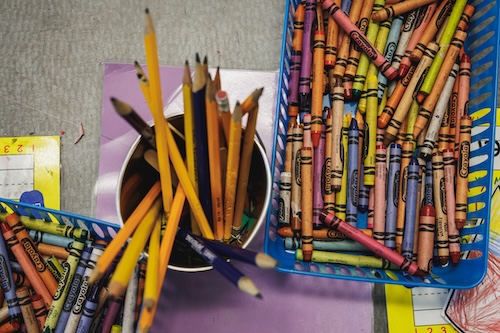
High-dosage tutoring is one of the most effective ways to help students quickly make up lost academic ground. Given the strong evidence base, largely from pre-pandemic years, showing that students who complete high-dosage tutoring post impressively large gains on test scores, many districts across the country have created or expanded tutoring programs. The Biden Administration even recommended high-dosage tutoring programs to help students recover from pandemic-related learning disruptions just last month.
Quality is critical. While the design of specific high-dosage tutoring varies, programs typically involve tutoring in one-on-one or small groups for sessions that are at least 30 minutes long and take place at least two to three times per week. Prior guidance on the best ways to implement high-dosage tutoring indicates schools should schedule sessions during the school day, keep tutoring one-to-one or in small groups, and incorporate other important features, like using high-quality, aligned curricula and fostering supportive tutor–student relationships.
In a new brief, our research team reviews the evidence base around high-dose tutoring, explains why focusing on high-dosage tutoring with at-risk students makes the most sense, and then highlights design principles to guide districts’ ongoing efforts. Here are five key takeaways from our review of the research.
1. Focus high-dosage tutoring programs on academically at-risk students
In too many parts of the country, students remain behind their pre-pandemic levels of achievement. Moreover, students who entered the pandemic with lower test scores experienced a larger drop in achievement compared to their higher-achieving peers. As a result, districts are facing an unprecedented number of students who qualify as academically at-risk, which we define as students who require intensive support outside of classroom instruction to learn grade-level skills or pass coursework necessary for later academic success and school completion.
Those academically at-risk students stand to benefit the most from intensive supports like high-dosage tutoring, which can help improve academic outcomes by personalizing instruction and fostering supportive relationships that build engagement and motivation in learning. Plus, high-dosage tutoring has consistently shown larger benefits for students’ test scores relative to other interventions targeted at low-achieving students, for example, technology-enabled programs, professional development, and curriculum reforms.
2. Use assessments and data to evaluate student skills targeted for intervention, monitor learning progress, and document other factors that affect learning
While interim and summative assessments can help identify academically at-risk students, districts can also use additional assessments—often formative and informal in nature—to evaluate the specific skills targeted for intervention and to document students’ existing strengths and areas for improvement so that tutoring can be tailored accordingly. For example, assessments that can guide progress monitoring of high-dosage tutoring programs include sub-tests for literacy or math skills (e.g., decoding, word recognition, numbers sense), teacher input, measures of student progress through the tutoring curriculum, and researcher-developed assessments designed to capture the specific skills targeted for intervention.
3. Be open to tutors with different skills and qualifications than classroom teachers, but monitor program implementation
To meet the scale of student need for academic support without breaking the bank, districts may want to consider hiring less skilled tutors to reduce program costs and overcome labor shortages. Because the small-group environment of tutoring is less complex than a regular classroom, research suggests districts can hire tutors across a range of experience and qualifications (e.g., volunteers or college students instead of certified educators) without sacrificing gains in student achievement.
Still, districts that go this route should consider implementing robust systems and procedures to ensure high-quality implementation. For example, districts could supply tutors with scripted instructional materials, intensive training, and ongoing supervision and feedback from on-site tutor supervisors. Districts can also observe and rate tutor sessions for fidelity and track data on student progress through the assigned curriculum.
4. Evaluate the effectiveness of high-dosage tutoring programs on specific skills and for specific students
Not surprisingly, high-dosage tutoring programs tend to show the biggest impact on skills targeted by the tutoring sessions. Recent literature reviews of early reading interventions show larger effect sizes for phonics- and fluency-related outcomes and smaller effect sizes for reading comprehension. We also see larger effect sizes in earlier versus later grade levels.
However, that means that interim and summative assessments may not be as responsive to high-dosage tutoring interventions if these assessments evaluate broader skillsets, such as all grade-level knowledge. Similarly, if districts are targeting high-dosage tutoring programs to certain at-risk student groups (e.g., multilingual learners, students with disabilities, chronically absent students), they may want to partner with researchers to evaluate the effects of the programs for these student groups.
5. Expect variation in the effectiveness of high-dosage tutoring programs
Although tutoring can be an effective tool for promoting academic recovery, there’s no guarantee it will work the same in every place, especially if program elements like personnel, curriculum, or scheduling vary. Evaluations of recovery programs such as summer school have found small effects on student achievement, with districts facing many challenges related to staffing, scheduling, student absences, and school-level capacity that have hindered program implementation and effectiveness.
The same types of problems could potentially affect district high-dosage tutoring programs. For example, tutoring program uptake and results can suffer when they depend on students to opt in. But, before writing it off entirely, districts should consider ways to strengthen their tutoring programs given the overwhelming evidence on high-dosage tutoring as an intervention strategy.
In closing
With the sunsetting of the federal ESSER funding, districts will need to be more strategic about how they design and sustain their high-dosage tutoring programs in the years to come. Districts that relied on the federal money to build out their tutoring programs should be thinking now about how to sustain those investments going forward, especially if their program is working but students are still behind.
As Accelerate CEO Kevin Huffman noted in The 74, high-dose tutoring programs have spread rapidly, thanks to local, state, and now national interest from the White House. Implementation details will matter immensely, but millions of young people stand to benefit if policymakers can sustain the political will. By learning from the research on high-dose tutoring programs, they can ensure high-dosage tutoring programs effectively serve the students who are most academically at risk and help them get back on track.







